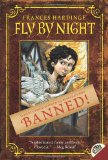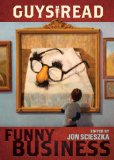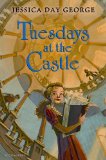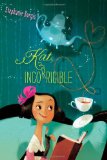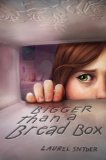Review of Fly By Night, by Frances Hardinge
by Frances Hardinge
performed by Jill Turner
Recorded Books, 2006. 14 hours, 12 compact discs.
Starred Review
I’d been meaning to read Fly By Night for quite some time, and listening to the recorded book ended up being a delightful way to do it. I always enjoy British narrators, and Jill Turner’s exquisite voice was the perfect way to highlight the extraordinary language contained in this book.
Frances Hardinge has an imagination not quite like anyone else’s. In the world she’s created for Fly By Night there are many different “Beloved” the people worship, and your name is given depending on the time when you are born, and the Beloved who is honored on that day. In the Prelude to this book, Mosca Mye has just been born after dusk, at the time sacred to Goodman Palpitattle, He Who Keeps Flies out of Jams and Butter Churns.
To give you just a taste of Frances Hardinge’s imagination, these are a few of the other Beloved:
Goodlady Cramflick, She Who Keeps the Vegetables of the Garden Crisp;
Goodlady Prill, Protector of Pigs;
Goodman Grayglory, He Who Guides the Sword in Battle;
Goodlady Agragap, She Who Frightens the Harelip Fairy from the Childbed;
and Goodman Blackwhistle of the Favorable Wind.
Her language is completely delightful to listen to. This book is full of similes that are both unique and wonderfully apt. A few examples of those:
As the story opens, she talks about the sleeping villagers:
“On this particular night their dreams were a little ruffled by the unusual excitement of the day, but already the water that seeped into every soul was smoothing their minds back into placidity, like a duck’s bill glossing its plumage.”
Describing the village:
“There was no escaping the sound of water. It had many voices. The clearest sounded like someone shaking glass beads in a sieve. The waterfall spray beat the leaves with a noise like paper children applauding. From the ravines rose a sound like the chuckle of granite-throated goblins.”
As it opens, Mosca wants to get out of the village where she lives with her uncle. She decides to free Eponymous Clent, who won over the town, but was then exposed as a fraud. She finds him hanging upside-down on the Chiding Stone, and tells him she’ll let him out if he gives her a job.
“‘I want to travel,’ Mosca declared. ‘The sooner the better,’ she added, with an apprehensive look over her shoulder.
“‘Do you even have the first idea of what my profession entails?’
“‘Yes,’ said Mosca. ‘You tell lies for money.’
“‘Ah. Aha. My child, you have a flawed grasp of the nature of myth-making. I am a poet and storyteller, a creator of ballads and sagas. Pray do not confuse the exercise of the imagination with mere mendacity. I am a master of the mysteries of words, their meanings and music and mellifluous magic.'”
And so the tale begins. Mosca goes off with Eponymous Clent and her pet goose Saracen, who attacks (and defeats) anyone but Mosca. They head for the city of Mandelion, and on the way, in one of my favorite scenes, they come across a coach being attacked by a bedraggled band of highwaymen. Clent recognizes the duchess inside the carriage and asks her for a job if he can keep the highwayman from robbing her.
Clent tells the highwayman, named Blythe, that a young lady inside is very ill and needs her money to get to a doctor. Blythe plans to steal from her anyway, but then asks what he stands to lose.
“After a moment’s dramatic pause, Clent let his arms drop.
“‘I am a writer of ballads — I value gestures. I understand them. I know what I can do with them. Let us suppose, for example, that you allowed this young woman to stay in her carriage, handed her back her money, and wished her and her people godspeed back to Mandelion so that she could find a physician who might save her life — ah, what I could do with that!’
“Blythe’s eyes asked silently what Clent could do with that.
“‘I could write a ballad that would make proverbial the chivalry of Clamoring Captain Blythe. When you rode the cold cobbles of a midnight street, you would hear it sung in the taverns you passed, to give you more warmth than that thin coat of yours. When you were hunted across the moors by the constables, hundreds would lie sleepless, hoping that brave Captain Blythe still ran free.
“‘And when at night you lay on your bed of earth under your dripping roof of bracken, with no company but the wind and your horse champing moss near your head, you would know that in a glittering banquet hall somewhere, some young lady of birth would be thinking of you.
“‘That is what you stand to lose.'”
The wild adventure that follows is not a simple case of good versus evil, because it’s hard to tell who is good and who is bad, though we know all along that we’re rooting for Mosca. Yes, we see Captain Blythe again, and yes, the ballad has consequences. In fact, all kinds of things from early in the book are woven together later in the book. The plot is imaginative, intricate, and most enjoyable.
I didn’t find this book particularly heart-warming. But I did find it delightful intellectual fun. The language is rich and melodious, the world-building is imaginative and funny, and the plotting is clever and well-woven.
In the words of Mosca’s father, Quillam Mye:
“There is only one thing that is more dangerous than Truth. Those who would try to silence Truth’s voice are more destructive by far.”
I like the Disclaimer at the end:
“This is not a historical novel. It is a yarn. Although the Realm is based roughly on England at the start of the eighteenth century, I have taken appalling liberties with historical authenticity and, when I felt like it, the laws of physics.”
This is a good yarn that kids of all ages will enjoy. The audiobook would make a fantastic family listen-along for a wide span of ages.
Find this review on Sonderbooks at: www.sonderbooks.com/Childrens_Fiction/fly_by_night.html
Disclosure: I am an Amazon Affiliate, and will earn a small percentage if you order a book on Amazon after clicking through from my site.
Source: This review is based on a library audiobook from the Fairfax County Public Library.
